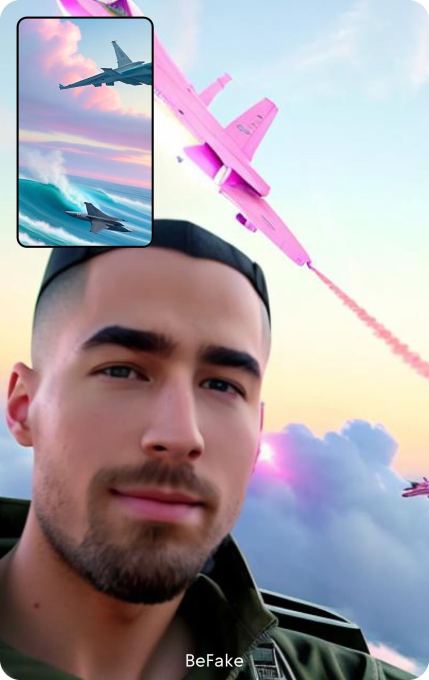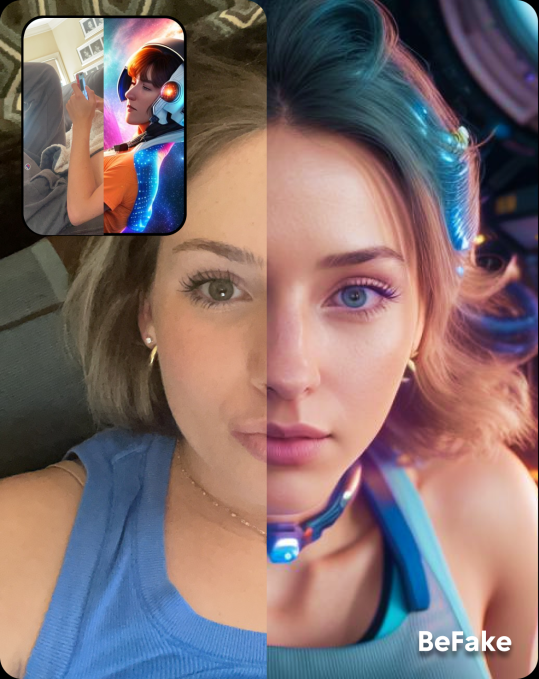AI-powered BeFake is a real app, not a BeReal parody…and it has $3M in funding
BeFake, a social networking app that combines concepts from popular Gen Z app BeReal along with AI technology has netted itself $3 million in seed funding to create an AI-augmented social network. The app’s name, a clear reference to BeReal’s authentic photo sharing among friends, is meant to suggest it does the opposite. Instead of showing what you’re up to right now, BeFake users also snap photos with both the front and back cameras, but then customize their photos using AI technology using either in-app presets or custom prompts.
The app is the creation of Alias Technologies, an applied AI company that uses generative media and multi-modal AI systems to create social media applications.
Alias was founded in 2021 by Kristen Garcia Dumont and Tracy Tracy Lane, the former executive team behind the gaming giant Machine Zone which was acquired by AppLovin in 2020. At Machine Zone, Dumont served as CEO leading the development and launch of two profitable mobile games, including World War Rising and Final Fantasy XV: A New Empire, grossing north of $1 billion. Lane, meanwhile, was the former COO, where she handled community, moderation, compliance, and platform partnerships.

Now the founders want to riff on the real-time social network BeReal’s concept of push notification-driven posting with their own app, which instead leverages Alias’ AI technology that lets users input text prompts to turn their photos into AI-augmented visuals. The idea is to let users express not necessarily their total authenticity, but rather their authentic creativity.
Despite being in a seemingly different market from gaming, Dumont says there’s a lot more overlap between the two industries than some may realize.
“We leveraged AI for monetization,” she explains. That is, “What’s the right thing to offer a player…when do you offer a sale, what do you put in the sale, how does the sale look, what’s the best way to monetize that specific user?,” Dumont continues. “But we also then started to leverage it in terms of player matching.”
What they found was that when the algorithms worked, players were better retained and created relationships with each other, even though they were strangers from different parts of the world.
The idea of gamers making connections with one another without using their real-world identities then planted the seed for BeFake.
“They have a separate digital identity that they leverage. And to see that the magical connection develop because algorithms got it right was definitely a spark moment,” Dumont notes.


With BeFake, the mechanics are similar to other front-back apps like BeReal or its older precursor, Frontback. Users first capture front and back photos from their phone, but then either pick out a preset or type out their own prompt to create an AI image.
The app offers both style prompts and custom location prompts, which include things like fantasy imagery or letting you put yourself on the top of Mount Everest, for example. Otherwise, users can type out their own prompts to create images of themselves in scenarios they imagine.
Under the hood, the company is using Stable Diffusion with a custom denoising loop. Its pipeline’s proprietary components are focused on the fact that the app is meant to be a social network. That means it needs to work with all kinds of different photos, like candids, zoomed-in photos, photos with multiple people, and so on.

Image Credits: BeFake
And unlike some other AI apps on the market, BeFake doesn’t require users to upload dozens of selfies to get started. Plus, it applies its AI-powered changes in under 30 seconds — and usually in less than 10. However, users spend, on average, at least 10 minutes per session as they design their AI creations.
The augmented photos can be shared with friends or in the main discovery feed where AI creators could build a following, or they can posted to other social networks. You can also toggle back and forth from the normal photo to the AI version, which can be fun. The company believes its concept will make for a more interesting feed than on BeReal as every photo will look unique.

Image Credits: BeFake
Asked why they picked the name “BeFake,” which obviously makes the app sound like a parody of BeReal as opposed to a more serious attempt to build a standalone social network, Dumont explained that they were attempting to reject current social media — the “whole concept where you either need to Facetune yourself or perfectly curate yourself.”
She says even BeReal is fake, as its users started to curate their “real” moments on the app.
“It was hurry, run downstairs and pretend you have 20 friends. Brush your hair, take a side pic, right? It was anything but being authentic,” she says. “So it’s less about BeReal and it’s much more about this full and total rejection of the authenticity movement, which is inauthentic,” Dumant adds.
As BeFake was launched on the App Store and Google Play just this month, the company is declining to share downloads or user adoption metrics, but notes that it’s seeing triple-digit week-over-week growth so far.
BeFake generates revenue through subscriptions which allow users to pay for the compute time to create the AI images, so they can post outside the time window or more than once per day. The subscriptions cost $2.99/week, $9.99/mo. or $99.99/year. However, the company does send a consistent push notification daily to alert users to a 20-minute block of time when they can use the app to make their AI images for free.
Going forward, BeFake founders believe their background in gaming will help them to stay relevant, as they learned you have to quickly adapt to users’ evolving tastes in order to retain them in the long term.

Image Credits: BeFake
“Part of what we’ve built under the hood is the ability to deploy changes to the app almost on a dime, similar to gaming so that we can respond to consumer tastes,” Dumont says.
“The moat with most AI apps is not going to be the underlying technology. We have a proprietary portion of our pipeline. I’m sure other people do as well. But what you want to be able to do is leverage open source tools. And as the open source tools get better, so do you because you get to leverage those,” she continues. “So you don’t want to be too precious about your engineering pipeline. Your moat is your community — that’s the moat in AI apps. So we’re very focused on building out that community and in order to do that you need to be able to be hyper-responsive to your community.”
One way the company is already moving in this direction is by learning what AI images users liked to make its algorithms better.
The 12-person, remotely-distributed company is also today announcing it’s backed by $3 million in seed funding led by Khosla Ventures. Other investors in the round include Next Coast Ventures, Maveron Ventures, Peter Thiel, Joe Lonsdale, and WS Investments. The round closed in April 2022, but hadn’t yet been reported.


